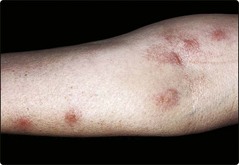Infestations
Infestation is defined as the harbouring of insect or worm parasites in or on the body. Worms – on or in the skin – are infrequent except in tropical countries. Insect life on the skin is usually transient in temperate climes, although a mite (Demodex folliculorum) may live harmlessly in facial hair follicles.
Insects cause a variety of skin reactions (Table 1). Contact with an insect or an insect bite can produce a chemical effect, such as a bee sting, or an irritant effect, such as dermatitis from contact with a caterpillar or blistering due to cantharadin released from a crushed beetle. Contact may also cause an immune-mediated response.
Table 1 Insect effects on the skin
| Insect | Effect |
|---|---|
| Animal ticks | Bites, disease vector |
| Ants, bedbugs, fleas | Bites |
| Bees, wasps | Stings |
| Caterpillars | Dermatitis |
| Cheyletiella | Papular urticaria |
| Demodex folliculorum | Normal inhabitant |
| Food and harvest mites | Bites |
| Lice | Infestation (bites), disease vector |
| Mosquitoes | Bites, myiasis, disease vector |
| Sarcoptes scabei | Scabies |
Insects act as vectors of skin disease, as in Lyme disease (p. 51), when animal ticks transmit Borrelia burgdorferi. They involve the skin directly by burrowing (e.g. scabies) or by laying eggs that hatch into larvae (myiasis).
Insect bites
Clinical presentation
The lesions of insect bites vary from itchy wheals (Fig. 1) through papules to quite large bullae (Fig. 2). The morphology will depend on the insect (Table 1) and the type of response elicited. Insect bites are usually grouped or track up a limb. Papular urticaria defines recurrent itchy urticated papules on the limbs or trunk, quite often in a child. The culprits, which may be difficult to trace, include garden insects, fleas or mites on household pets. Bedbugs cause bites on the face, neck and hands. They lie inactive in crevices in furniture during the day and emerge at night. Secondary bacterial infection of excoriated insect bites is common.





